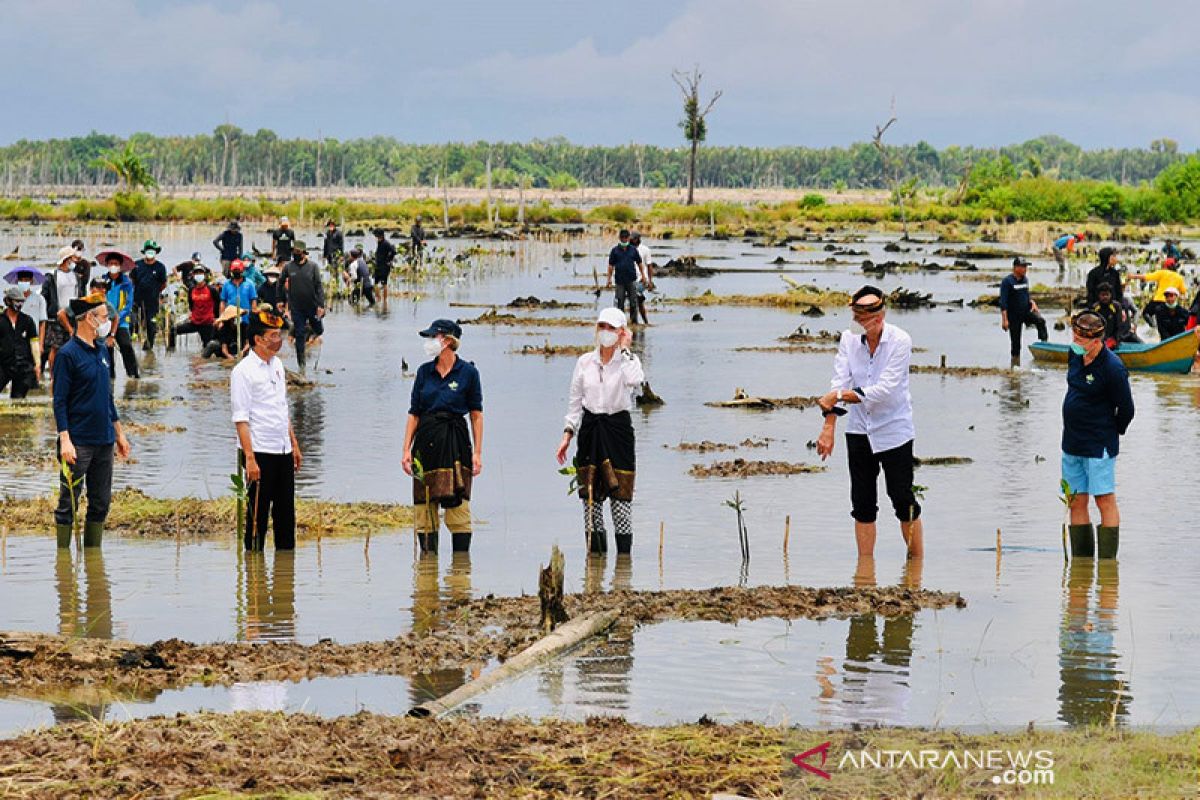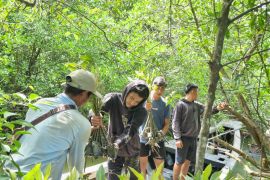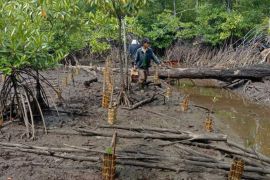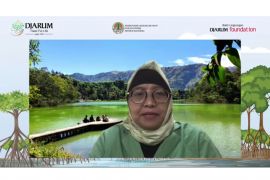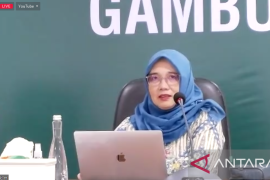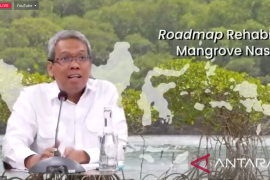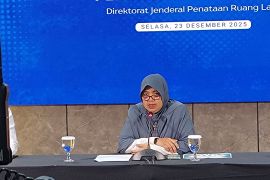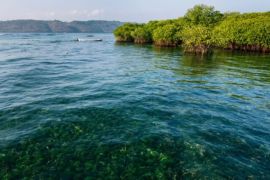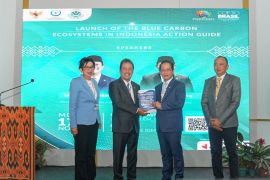The world’s largest archipelagic country sees the preservation of mangrove forests as crucial because of their role in providing habitats for aquatic and terrestrial fauna and flora, protection from strong winds and waves, soil stabilization and erosion prevention, nutrient retention and water quality improvement through filtration of sediments and pollutants, flood mitigation, sequestration of carbon dioxide, and protection of associated marine ecosystems.
As high carbon storage ecosystems, mangrove and peatland ecosystems play a strategic role as nature-based solutions for climate change mitigation and adaptation. Peatlands and mangroves store up to 2 to 10 times more carbon than forests.
Given the significant role of mangrove and peatland ecosystems, the government has recently converted the Peatland Restoration Agency (BRG) into Peatland and Mangrove Restoration Agency (BRGM).
Mangroves, however, have been disappearing more quickly than inland tropical rainforests, particularly due to clear-cutting for shrimp farms.
The loss of mangroves has led to a decline in fisheries, degradation of clean water supply, salinization of coastal soils, erosion and land subsidence, as well as an increase in gas emissions, among other things.
Related news: President seeking to restore 600,000 hectares of mangrove forests
President Joko Widodo (Jokowi), while visiting Tana Tidung district, North Kalimantan province, on October 19, 2021 had revealed that the country’s existing mangrove forests covered a total area of 3.6 million hectares.
Rehabilitation efforts are being undertaken to protect coastal areas from sea waves, seawater intrusion, and preserve the habitat of species, including birds, fishes, crabs, monkeys, and other flora and fauna, living in and around the mangrove forests, according to him.
Accompanied by several foreign ambassadors, Widodo planted mangrove trees in North Kalimantan as part of the mangrove restoration program.
The program’s funds were derived from various sources, including state and regional budgets, Corporate Social Responsibility (CSR) programs of private and state-owned companies, and the community in general, he noted.
Earlier, the President had called on regional governments to take a cue from the model of mangrove rehabilitation at Bali's Ngurah Rai Forest Park.
Accompanied by the Minister of Environment and Forestry, Siti Nurbaya Bakar, he, on October 8, 2021, visited the forest park to review the implementation of mangrove planting activities.
"We will continue to do this in coastal areas to restore and preserve our mangrove forest areas and also to anticipate and mitigate impacts of global climate change," he remarked.
The Ngurah Rai Forest Park, which was developed in 2003, is a pilot project for mangrove rehabilitation efforts that combines education and tourism.
The park is administratively located in Tanjung Benoa and its surroundings in Kuta and South Kuta sub-districts, Badung district (covering an area of 627 hectares), and in Serangan Island, South Denpasar sub-district, Denpasar city (spanning an area of 746.50 hectares).
The mangrove park has abundant natural beauty and biodiversity including bird species, and aquatic species, such as fish, mollusks, and shrimps.
The government has emphasized that efforts to control the effects of climate change in the marine and coastal sectors are highly dependent on coastal and marine conservation since coastal ecosystems, such as mangroves and seagrasses, can store and produce carbon, which is better known as blue carbon.
Related news: Jokowi urges regions to emulate Bali's mangrove rehabilitation
Blue carbon is currently considered an important ecosystem since it can absorb greenhouse gas emissions.
In fact, Indonesia has vast blue carbon potential on account of the presence of about 3.3 million hectares of mangroves that can store 950 tCO2e of carbon per hectare and about three million hectares of seagrass beds that can store 119.5 tCO2e of carbon per hectare.
Hence, the Environment and Forestry Ministry is continuing to encourage the inclusion of blue carbon in the Nationally Determined Contributions (NDC) document considering its potential to store carbon, according to the ministry’s director general of climate change control, Laksmi Dwanthi.
NDC is an emission reduction contribution document that reflects the commitment of each state party in the Paris Agreement, she explained.
Indonesia's blue carbon potential can be found in its large marine area, which contains 23 percent of the world's mangroves ecosystem, she noted.
"It is a very significant area related to the potential carbon absorption, not only in Indonesia but also at the global level," she said.
Environment and Forestry Minister Siti Nurbaya as well as Maritime Affairs and Fisheries Minister Sakti Wahyu Trenggono have held discussions with experts on assessing how far Indonesia can include the blue carbon potential in the context of climate change mitigation, she added.
In the context of adaptation, the ministry has taken various steps and programs to make the policy mainstream, especially in coastal areas, for instance by implementing the Climate Village Program, she informed.
In addition, Indonesia has cooperated with other archipelagic countries--Fiji and Costa Rica--to submit a proposal to integrate marine aspects in climate change issues at the UN Climate Change Conference COP25 in 2019, she added.
Related news: Environment, Forestry Ministry drives blue carbon inclusion in NDC
Minister Nurbaya Bakar launched the 2021 National Mangrove Map on October 13, 2021 for the preservation of the country’s mangrove forest area.
The latest data from the National Mangrove Map shows that Indonesia has 3,364,080 hectares of mangroves, an increase of 52,873 hectares from 3,311,207 hectares in 2013-2019.
In the 3,364,080 hectares of mangrove land, there are variations in canopy classification from good to sparse, the minister said.
Concerning mangrove lands with sparse canopy to damaged canopy, the government is targeting to recover around 600 thousand hectares by 2024, she added.
Nurbaya reaffirmed the government’s commitment to mangrove preservation efforts by successfully transforming fishponds into mangrove ecosystems again.
As for the 2021 mangrove rehabilitation program’s target of restoring 34 thousand hectares of mangroves, the BRGM is upbeat that it can be achieved.
Head of BRGM, Hartono, said that the agency will continue to plant mangroves in nine provinces: North Sumatra, Bangka Belitung, Riau Islands, Riau, West Kalimantan, East Kalimantan, North Kalimantan, Papua, and West Papua.
"In order to expedite mangrove rehabilitation, we are also involving local residents through the labor-intensive method, so that the mangrove planting target can quickly be achieved," he informed.
The government hopes that the program will benefit people by improving their standard of living and purchasing power, thus making them prosperous.
In addition, the program is also expected to support efforts to accelerate economic recovery post-COVID-19.
Related news: Indonesia commits to enhancing blue carbon contribution to national policy
Editor: Suharto
Copyright © ANTARA 2021
